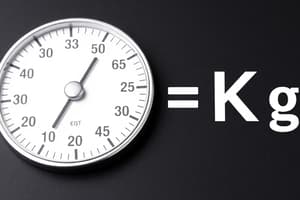Podcast
Questions and Answers
Which metric prefix represents 10^3 times the base unit?
Which metric prefix represents 10^3 times the base unit?
- hecto-
- kilo- (correct)
- milli-
- micro-
What is the relationship between kilograms and grams as stated in the Ontario grade 4 math curriculum?
What is the relationship between kilograms and grams as stated in the Ontario grade 4 math curriculum?
- Kilograms and grams are unrelated units of measurement.
- Students should understand the relationship between kilograms and grams. (correct)
- The curriculum does not mention the relationship between kilograms and grams.
- Kilograms and grams are used to measure different physical quantities.
Which of the following is the correct way to convert from a larger metric unit to a smaller metric unit?
Which of the following is the correct way to convert from a larger metric unit to a smaller metric unit?
- Multiply by a power of ten. (correct)
- Use a conversion factor that involves subtracting.
- The text does not provide information about converting between metric units.
- Divide by a power of ten.
What is the main purpose of using metric prefixes as described in the text?
What is the main purpose of using metric prefixes as described in the text?
What is the relationship between liquid volume and capacity?
What is the relationship between liquid volume and capacity?
Which of the following is NOT a key concept or skill that students in grade 4 in Ontario are expected to learn according to the math curriculum described in the text?
Which of the following is NOT a key concept or skill that students in grade 4 in Ontario are expected to learn according to the math curriculum described in the text?
What is the fundamental difference between mass and capacity?
What is the fundamental difference between mass and capacity?
Which metric unit is commonly used to measure mass in the metric system?
Which metric unit is commonly used to measure mass in the metric system?
If 1 kilogram is equivalent to 1000 grams, how many grams are equivalent to 3 kilograms?
If 1 kilogram is equivalent to 1000 grams, how many grams are equivalent to 3 kilograms?
Which unit of measurement is used for capacity in the metric system?
Which unit of measurement is used for capacity in the metric system?
What is the relationship between 1 liter and 1000 milliliters?
What is the relationship between 1 liter and 1000 milliliters?
How does gravity affect mass and capacity differently?
How does gravity affect mass and capacity differently?
Flashcards are hidden until you start studying
Study Notes
Mass and Capacity in the Metric System
In the metric system, two key concepts related to measurement are mass and capacity. Both mass and capacity play essential roles in everyday life and scientific applications, making it crucial to understand these concepts' fundamentals. Let's delve deeper into mass and capacity in the metric system, along with relevant subtopics such as metric prefixes, unit conversions, and the Ontario math curriculum for grade 4 students.
Mass
Mass refers to the amount of matter an object contains. In the metric system, mass is typically measured in grams (g) or kilograms (kg). There are several relationships between these units:
- 1 kg is equivalent to 1000 g.
- 1 kg of water occupies a volume of 1 L.
- 1 lb is approximately equal to 0.454 kg.
Gravity affects an object's weight, but it does not affect its mass. While your weight may vary depending on your location due to differences in gravitational pull, your mass remains constant regardless of where you go.
Capacity
Capacity refers to the ability to contain a certain amount of substance or material. In the metric system, capacity is usually measured in milliliters (mL) or liters (L). Some notable relationships include:
- 1 L is equal to 1000 mL.
- 1 L is roughly equivalent to 0.264 US gallons.
- 1 mL is equivalent to 1 cc.
It's interesting to note that capacity is closely linked to the concept of volume. When considering fluids, liquid volume and capacity can be thought of interchangeably, meaning that the amount of fluid you pour from a jug determines its capacity.
Metric Prefixes
The metric system uses prefixes to denote multiples or fractions of base units. Some commonly used prefixes include:
- kilo-, meaning 10^3 times; for example, kilogram (kg).
- hecto-, meaning 10^2 times; for example, hectometer (hm).
- milli-, meaning 10^-3 times; for example, millimeter (mm).
- micro-, meaning 10^-6 times; for example, micrometer (µm).
These prefixes allow us to express larger or smaller units of measurement more conveniently and efficiently.
Unit Conversions
Converting between metric units is relatively straightforward because the system is based on multiples of ten. To convert from one unit to another, you simply need to apply the appropriate conversion factor, which involves multiplying by a power of ten. This makes conversions easier than in other systems, as no additional reference points are required.
Grade 4 Ontario Math Curriculum
In Ontario's grade 4 math curriculum, students learn about measurements and data collection using both customary and metric units. They should be able to:
- Convert between basic units for length, mass, volume, and capacity.
- Understand that there is a relationship between kilograms and grams, liters and millilitres, and so on.
By focusing on these concepts and skills, students build a solid foundation in understanding and utilizing the metric system effectively.
In conclusion, the metric system offers a consistent and efficient approach to measuring various quantities such as mass and capacity. By mastering key concepts like metric prefixes and unit conversions, along with the basics of length, weight/mass, and capacity, individuals can confidently navigate measurements in their daily lives and scientific pursuits.
Studying That Suits You
Use AI to generate personalized quizzes and flashcards to suit your learning preferences.




